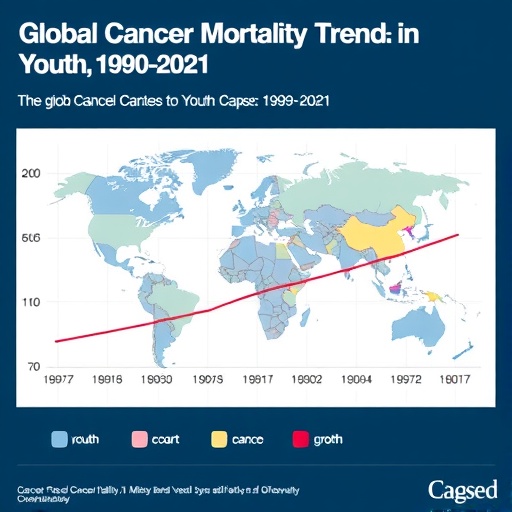
In an unprecedented global analysis spanning over three decades, researchers have unveiled critical insights into cancer mortality rates among children, adolescents, and young adults across 77 countries. This expansive study, which utilizes comprehensive time-series analyses and sophisticated modeling approaches, sheds new light on the evolving landscape of pediatric and young adult oncology from 1990 through 2021. These findings represent a crucial step forward in understanding the disparate trends in cancer outcomes worldwide, with major implications for public health policy, resource allocation, and clinical intervention strategies in vulnerable populations.
The study meticulously compiled data covering a diverse range of nations, providing an unparalleled global view of mortality trends that have remained elusive until now. By integrating datasets across continents, researchers could identify patterns and shifts in cancer-related deaths within young populations, a demographic historically overshadowed by adult oncology statistics. These children and young adults, spanning ages from infancy to their mid-twenties, face unique biological challenges and societal dynamics, necessitating precise epidemiological characterization to tailor effective countermeasures.
A standout feature of this research is its longitudinal scope, tracking changes in mortality rates over 31 years. This extended timeframe permits not only the observation of immediate or regional fluctuations but also the evaluation of long-term trends and the impact of medical advancements, healthcare infrastructure development, and socio-economic transformation on cancer outcomes. It enables the discerning of whether global health initiatives have tangibly altered the trajectory of pediatric cancer survivorship or if persistent disparities continue to widen.
.adsslot_si70zcmvrj{width:728px !important;height:90px !important;}
@media(max-width:1199px){ .adsslot_si70zcmvrj{width:468px !important;height:60px !important;}
}
@media(max-width:767px){ .adsslot_si70zcmvrj{width:320px !important;height:50px !important;}
}
ADVERTISEMENT
Methodologically, the study employs advanced time-series analysis techniques, allowing researchers to discern subtle, non-linear trends and forecast potential future outcomes. When combined with robust statistical modeling, these methods provide a nuanced understanding of mortality shifts shaped by variables such as geographic location, economic status, healthcare access, and the prevalence of specific cancer subtypes. This analytical rigor is vital given the complexity and heterogeneity inherent in global cancer epidemiology.
One of the study’s most alarming revelations is the persistent disparity in cancer mortality across different countries and regions. Despite strides in oncology and pediatric care in high-income nations, many low and middle-income countries lag behind, with mortality rates exhibiting slower declines or, in some cases, alarming increases. This discrepancy underscores the urgent need to address inequities in diagnostic capabilities, treatment availability, and supportive care infrastructures globally.
Furthermore, the analysis accentuates particular types of cancers contributing disproportionately to mortality in younger demographics. Leukemias and brain tumors, for example, continue to be leading causes of death worldwide, but their relative burdens vary significantly by region. Such differentiation highlights the necessity for region-specific interventions and encourages investment in research focused on the molecular biology and treatment responses of cancers prevalent in underserved populations.
Importantly, the study dissects mortality trends not only by geographic regions but also by age subgroups—children versus adolescents and young adults—revealing nuanced patterns. While overall pediatric cancer mortality has decreased in many settings, certain age brackets have experienced stagnation or even worsening outcomes. This indicates that improvements in childhood leukemia survival, for instance, may not translate equally to adolescents, whose cancers often exhibit distinct biological behaviors and are complicated by social determinants of health.
The researchers also draw attention to the influence of socio-economic factors on cancer mortality among young populations. Socio-economic deprivation, limited health education, and inadequate healthcare infrastructure in under-resourced settings contribute to delayed diagnoses and suboptimal treatment adherence, exacerbating mortality risks. Addressing these social determinants is recognized as an imperative complementary strategy alongside medical advancements.
In addition to quantifying mortality trends, the study offers predictive modeling to estimate future mortality burdens under various scenarios. These projections highlight how continued inequities and insufficient investment could compound mortality rates in vulnerable regions, while also suggesting that targeted interventions and global cooperation may substantially improve survival outcomes. This forward-looking aspect equips policymakers with critical data to prioritize initiatives grounded in evidence-based expectations.
The interplay between infectious diseases, environmental exposures, and cancer incidence in young individuals is explored within the context of regional variability. Areas burdened by high rates of viral infections associated with oncogenesis, such as Epstein-Barr virus or hepatitis viruses, exhibit unique mortality patterns. Understanding these links enhances the importance of integrated approaches combining infectious disease control and oncology services to holistically reduce cancer mortality.
Moreover, the study discusses methodological challenges inherent in assembling global cancer mortality data, including variability in cancer registries, reporting accuracy, and cause-of-death coding practices. By employing harmonization protocols and rigorous quality assessments, the researchers have mitigated these issues, lending robustness to their findings and setting a precedent for future multinational epidemiological investigations.
The study’s findings impel a reevaluation of current pediatric and young adult oncology strategies worldwide. Despite significant biomedical breakthroughs and increasing survival rates in developed countries, the global picture remains fractured and inequitable. Addressing these disparities will necessitate not only scientific innovation but also concerted efforts in health system strengthening, equitable resource distribution, and the removal of systemic barriers to care.
Additionally, the importance of fostering international collaborations emerges strongly from this work. Sharing data, harmonizing treatment protocols, and enabling technology transfer can help bridge gaps between high- and low-resource settings. The study’s comprehensive dataset could serve as a baseline for monitoring progress and informing global health frameworks aimed at reducing childhood and young adult cancer mortality.
Beyond immediate clinical implications, the research holds broader relevance in the context of Sustainable Development Goals (SDGs), particularly those targeting good health and well-being. Reducing premature mortality from non-communicable diseases, including cancers, in younger populations aligns directly with global commitments to improve health equity and social justice on a planetary scale.
Ultimately, this groundbreaking global time-series and modeling study spotlight the urgent need to intensify efforts to combat cancer mortality among children, adolescents, and young adults. Its comprehensive scope, methodological sophistication, and insightful analysis provide a clarion call to the international medical and public health community to redouble investments in research, equitable care, and health system resilience to foster a future where every young person, irrespective of geography, has a fighting chance against cancer.
Subject of Research: Global cancer mortality trends among children, adolescents, and young adults from 77 countries between 1990 and 2021.
Article Title: Global cancer mortality among children, adolescents, and young adults from 77 countries, 1990–2021: a global time-series analysis and modelling study.
Article References:
Oh, J., Kim, S., Woo, S. et al. Global cancer mortality among children, adolescents, and young adults from 77 countries, 1990–2021: a global time-series analysis and modelling study. World J Pediatr (2025). https://doi.org/10.1007/s12519-025-00946-y
Image Credits: AI Generated
DOI: https://doi.org/10.1007/s12519-025-00946-y
Tags: adolescent oncology statisticscancer trends from 1990 to 2021clinical interventions for young patientsepidemiology of childhood cancersglobal cancer mortality trendsinternational cancer mortality analysislongitudinal studies in cancer researchmortality rates in vulnerable populationspediatric cancer outcomespublic health policy in oncologyresource allocation for cancer careyoung adult cancer research





